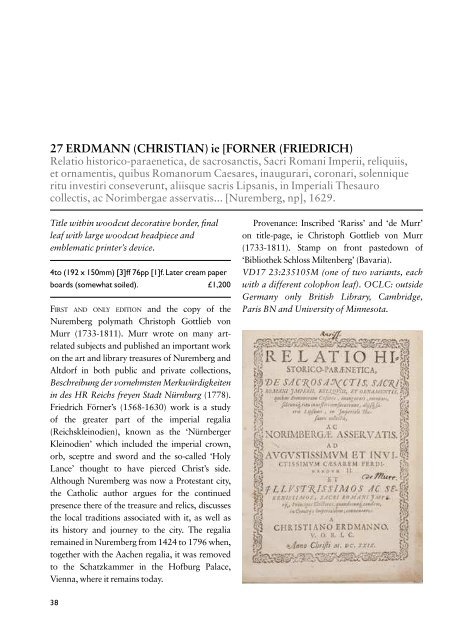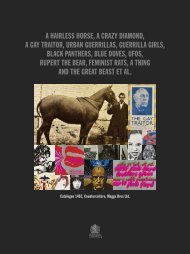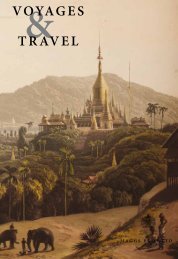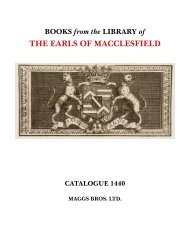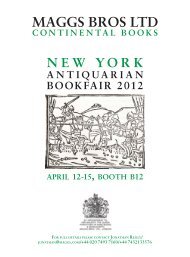CONTINENTAL BOOKS CATALOGUE 1448 - Maggs Bros. Ltd.
CONTINENTAL BOOKS CATALOGUE 1448 - Maggs Bros. Ltd.
CONTINENTAL BOOKS CATALOGUE 1448 - Maggs Bros. Ltd.
You also want an ePaper? Increase the reach of your titles
YUMPU automatically turns print PDFs into web optimized ePapers that Google loves.
27 ERDMANN (ChRISTIAN) ie [FORNER (FRIEDRICh)<br />
Relatio historico-paraenetica, de sacrosanctis, Sacri Romani Imperii, reliquiis,<br />
et ornamentis, quibus Romanorum Caesares, inaugurari, coronari, solennique<br />
ritu investiri conseverunt, aliisque sacris Lipsanis, in Imperiali Thesauro<br />
collectis, ac Norimbergae asservatis... [Nuremberg, np], 1629.<br />
Title within woodcut decorative border, final<br />
leaf with large woodcut headpiece and<br />
emblematic printer’s device.<br />
4to (192 x 150mm) [3]ff 76pp [1]f. Later cream paper<br />
boards (somewhat soiled). £1,200<br />
First And only edition and the copy of the<br />
Nuremberg polymath Christoph Gottlieb von<br />
Murr (1733-1811). Murr wrote on many artrelated<br />
subjects and published an important work<br />
on the art and library treasures of Nuremberg and<br />
Altdorf in both public and private collections,<br />
Beschreibung der vornehmsten Merkwürdigkeiten<br />
in des HR Reichs freyen Stadt Nürnburg (1778).<br />
Friedrich Förner’s (1568-1630) work is a study<br />
of the greater part of the imperial regalia<br />
(Reichskleinodien), known as the ‘Nürnberger<br />
Kleinodien’ which included the imperial crown,<br />
orb, sceptre and sword and the so-called ‘Holy<br />
Lance’ thought to have pierced Christ’s side.<br />
Although Nuremberg was now a Protestant city,<br />
the Catholic author argues for the continued<br />
presence there of the treasure and relics, discusses<br />
the local traditions associated with it, as well as<br />
its history and journey to the city. The regalia<br />
remained in Nuremberg from 1424 to 1796 when,<br />
together with the Aachen regalia, it was removed<br />
to the Schatzkammer in the Hofburg Palace,<br />
Vienna, where it remains today.<br />
Provenance: Inscribed ‘Rariss’ and ‘de Murr’<br />
on title-page, ie Christoph Gottlieb von Murr<br />
(1733-1811). Stamp on front pastedown of<br />
‘Bibliothek Schloss Miltenberg’ (Bavaria).<br />
VD17 23:235105M (one of two variants, each<br />
with a different colophon leaf). OCLC: outside<br />
Germany only British Library, Cambridge,<br />
Paris BN and University of Minnesota.<br />
28 EUSEBIUS pAMphILI, Bp OF CAESARIA Chronico[n]. Paris,<br />
Henri Estienne, 30 October 1518.<br />
Woodcut title-border, printed in red and black<br />
throughout, some Greek letter, criblé initials.<br />
4to (233 x 165mm) [20], 175 [ie 173]ff [1]f (blank).<br />
17th-century mottled calf, spine gilt in compartments<br />
(head of spine and joints restored) £1,600<br />
second henri estienne edition, following his<br />
first of 1512 when the Chronological Tables were<br />
extended to include the years 1482-1512.<br />
Eusebius’ Tables, arranged in parallel columns<br />
illustrating the history of the world year by year,<br />
end during the year 329 and the continuations are<br />
by St Jerome (to 381), Prosper Aquitanus (to 448),<br />
Matteo Palmieri (to 1449), Mattia Palmieri (to<br />
1481) and Joannes Multivallis (to 1512).<br />
Mattia Palmieri under 1457 refers to the<br />
invention of printing, ascribed to Johann<br />
Gutenberg in 1440: ‘Namque a Joanne Gutenberg<br />
Zuniungen equiti Maguntiae rheni solerti ingenio<br />
librorum Imprimendorum ratio 1440 inventa’.<br />
The account goes on to say how printing had<br />
extended over almost the whole world, and that<br />
the whole of antiquity was to be bought with a<br />
little money and would be read by our descendants<br />
in innumerable volumes.<br />
‘For the period covered by Multivallis, more<br />
space is given to an account of the arrival of<br />
seven savages at Rouen in 1509 than to any<br />
other event (leaf Y4v; generally thought to be<br />
Brazilians from this reference)’ (Mortimer).<br />
They could also have been Canadian aboriginals<br />
brought back from his 1508 voyage to the New<br />
World by Thomas Albert, the Dieppe pilot.<br />
Pencil notes and old catalogue cutting on<br />
endpapers. One or two small wormholes only<br />
occasionally affecting a letter.<br />
Renouard Estienne, p20-21, no 9 Mortimer I,<br />
no 217. Schreiber 28 cf Sabin 23114 and<br />
Harrisse 71, add 43 & 54.<br />
38 39


